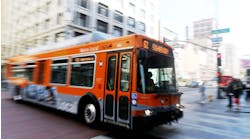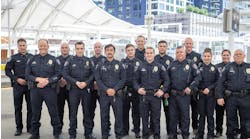IndigoVision has released a new free guide for transit surveillance to help agencies equip their security systems for the modern world.
While upgrading the transit surveillance system may sound like a hassle, if the system is outdated then it isn’t going to deliver the level of security necessary and won’t perform effectively, according to Rick Spillane, director of sales for USA East, IndigoVision. Spillane outlines eight signs to look for when considering upgrades to the transit surveillance system.
Sign 1: The quality of your footage isn’t fit for purpose
Poor-quality footage, or video which takes so long to process that it delays legal action, can be a common occurrence in transit environments and can cause problems with identifying culprits. Spillane explains why this might be the case with older security systems.
“Some companies out there use a server which becomes a bottleneck; when they're writing the file, too much happens at once,” Spillane said. “It slows down everything and then re-formats it so it can be written in a smaller format.”
If the CCTV system transcodes video or takes too long to export footage, then this could be one of the symptoms of the system needing modernizing.
Sign 2: It takes too long to perform cyber updates
Transit IT officers operate and maintain the technical equipment, but on old surveillance equipment, reducing network vulnerabilities can take large chunks of time to complete.
“The IT operator needs the ability to perform software upgrades over time because there are more software upgrades than ever,” Spillane said. “In years past, cyber wasn't as big of a problem or wasn't looked at as a big risk. But today, it’s a major driving importance for businesses.”
With newer security products, agencies can execute a 20,000 camera firmware update in two and a half hours. With older solutions though, this could take a week or more.
Sign 3: Your surveillance system isn’t easy to use or doesn’t integrate with other solutions
If an agency has had a system for a while, current employees may know the system very well, but to new people joining the business, the existing equipment might not be so easy to use. The solution could be cumbersome, slow or doesn’t work automatically, requiring a lot of manual input.
“IT departments want a solution where the equipment is easy to take care of and integrations are straightforward,” Spillane said.
Spillane notes many transit security officers use Linux with their newer cameras. As it’s an embedded product, it’s stable and integrates with Windows, so they don't have to do Windows updates, which can cause frustration.
Sign 4: You can’t balance automation and manual control
Analog and manual systems might make processes time-consuming, but it’s how a lot of IT operators prefer to work, since it’s what they’ve always known and gives them a sure way to feel in control, explains Spillane.
“With old analog systems, the operators that use them enjoy using a keyboard that allows them to punch in a number such as: camera 198, then use the joystick to move the camera around,” Spillane said.
Relinquishing control may worry some operators, but modern IP system technology allows operators to use a combination of manual or automated instead of choosing one or the other.
“There’s now a product that does so much of the manual jobs for you,” Spillane said. “But it still respects the traditional style of controlling a camera, and brings it into the 21st Century way of doing things— everything operating from one hub.”
Sign 5: You can’t access your footage anytime from any device
Lack of flexibility about where in the station operators can view footage could be frustrating. For instance, operators can only view camera footage from a central control room. In the event of an emergency, this could be an issue if there’s no access to the control room.
“If you want to look at a camera instead of looking at it from your phone, from your laptop, or from your iPad, you have to look at the unit which runs through the server and out to the camera from a fixed position,” Spillane said.
Operators can benefit from being able to pick up a phone or tablet and check the cameras from there, providing visibility throughout the transit system even when on the move.
Sign 6: You don’t use Artificial Intelligence to enhance your security
Artificial Intelligence (AI) can allow agencies to monitor and regulate people flow and break down passengers into specific groups, which provides data to inform future safety procedures.
“If you go into the AI side of things, you could look at things like how many women are actively showing up from eight to nine o'clock, versus men,” Spillane said.
Implementing AI to find out more about the people traveling through the transit hub could help build a broader picture of the security requirements needed. By being able to analyze data for patterns to inform future surveillance decisions, agencies can plan for vulnerable groups or scenarios not previously considered.
Sign 7: Your team can’t access footage at the same time
If the wider team at the transport hub does not always communicate well and share intelligence, this might be due to the technical limitations of the CCTV system, such as cameras crashing if they’re overloaded with too much activity.
“If something bad happens at the train depot, all of a sudden, you might have 100 people trying to look at the camera, all at the same time,” Spillane said. “In most systems, if 100 people go to look at a single server at one time, that server will crash.”
If an existing transit surveillance system relies on servers, or if multiple people try to view recorded footage at once and the system buckles under strain, it may be time for a change. With an IP alternative, multiple authorities can view footage all at once – meaning no delays and no danger of losing or corrupting footage.
Sign 8: Your cameras aren’t capturing what they need to (or capturing too much)
As transit environments grow, sometimes cameras get neglected, meaning they don’t continue to monitor the most crucial areas. It could be that there isn’t enough camera coverage across certain areas. Meanwhile, the cameras could be capturing too much of other areas or picking up things they shouldn’t be.
“When you move a Pan Tilt Zoom (PTZ) camera around, you can mask out people's windows,” Spillane said. “So, if you've got a camera facing an apartment building across the street, you can program those windows to be blacked out, so no-one is looking in.
Agencies should consider what contingencies are in place to help maximize the effectiveness of their existing equipment or minimize disruption to those around the station.
If any of these eight signs feel familiar, then it might be time to start thinking about moving towards modernizing the transit surveillance system. Access IndigoVision’s free transit surveillance guide on its website to learn more.



